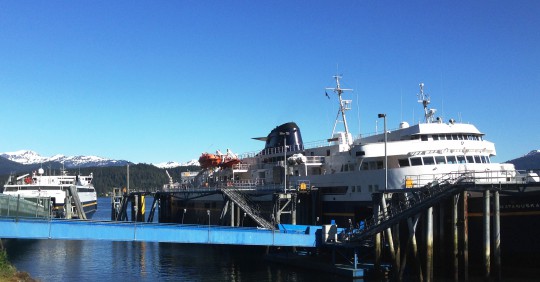
The ferries Matanuska, right, and Fairweather, left, tie up at Juneau’s Auke Bay Ferry Terminal May 19, 2016. (Photo by Ed Schoenfeld/CoastAlaska News)
A steering committee is pursuing legislation to transition the Alaska Marine Highway ferry system to a public corporation. At last week’s Ketchikan Chamber of Commerce luncheon, Robert Venables , executive director of Southeast Conference, discussed a multi-stage project to reform the AMHS.
Over the past five years, there has been a $35 million decline in state funding for the Alaska Marine Highway. Venables says because of budget cuts, an aging fleet and a misalignment between labor and management, ferry service has declined. He says Southeast Conference and the State of Alaska are partnering to reform and revive the system.
“We were approached two years ago by Lt. Governor (Byron) Mallott and he used the words, ‘the system is in crisis.’”
Venables says decreased funding and scheduling uncertainties have resulted in decreased revenue. He says the plan is to institute reform measures to add viability and sustainability to the system.
Venables says the first stage of the project was to identify the mission and goals. That was done in 2017. He says the recommendation at the end of phase one was to explore forming a public corporation. Venables says the focus of phase two was to develop a long-term operation and business strategy based on the public corporation model.
Throughout his presentation, Venables emphasized that there is no plan to privatize AMHS.
“And we’ve been saying this for two years. There’s not an effort to try to privatize the Alaska Marine Highway System. It has a public service mission that is always going to be key underlying to the function of the Marine Highway System. It’s always going to have the public participation fiscally to make it work.”
Venables says there are opportunities to partner with municipalities, tribes and private businesses that could add to the revenue stream.
“But, it will always be assets owned by the state with a mission for the public. So I want make sure that people understand that that’s the underlying premise of this entire effort.”
Venables says the committee studied possible new revenue sources, ways existing revenue sources might be strengthened, how to model the fleet, and the public-corporate structure. He says the AMHS is a complex system.
“We’ve got nine different vessels out there trying to call on 33 different ports with a very aging fleet, and a lot of different things going on. And underlying all of that is a system that just costs a lot to operate.”
Venables says the committee wants to make sure state and federal funding could still flow to a public corporation.
“…and yes they can. And we want to make sure it’s well understood that the system, very much, has a public purpose. Did I mention that it has a public service mission and that we’re not trying to privatize it?”
Venables says the next phase is to introduce legislation and build public support. He says House Bill 412 was introduced this past session. Though not what the AMHS reform committee recommended, he says it’s a start and will undergo changes. In addition to reviewing the bill and speaking to legislators, Venables says individuals and corporations can provide financial support to the reform effort. An audience member asked how donors would benefit from this.
“The primary thing that they’re getting is hope for tomorrow for the Marine Highway System because this is funding an effort that is focused on making the Marine Highway System viable and have a future for the next generation.”
Venables says it will likely take two to four years to establish a public corporation.
Southeast Conference is a regional, non-profit corporation that promotes economic development and healthy communities. It was formed in 1958 to advocate for the establishment of a transportation system for Southeast Alaska, which eventually became the Alaska Marine Highway.








